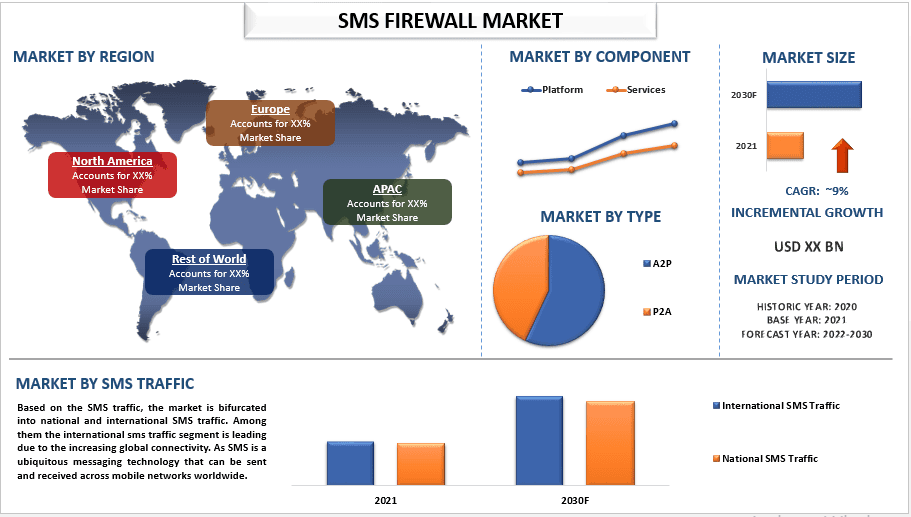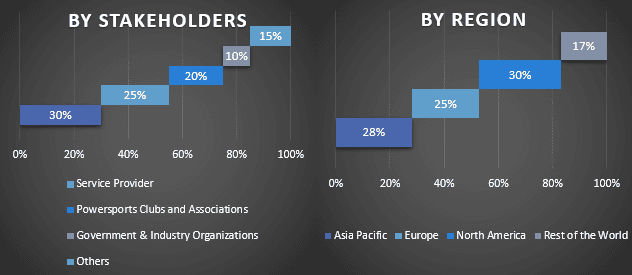- Home
- About Us
- Industry
- Services
- Reading
- Contact Us
SMS Firewall Market: Current Analysis and Forecast (2022-2030)
Emphasis on component (platform and services); Type (Application to Person (A2P), Person to Application (P2A)); Deployment mode (on-premise, cloud); SMS Traffic (National SMS Traffic and International SMS Traffic); End-Users (BFSI, Healthcare, Government & Public Sector and others)

The SMS Firewall Market is expected to grow at a steady rate of around 9% owing to the increasing mobile network security threats. Many countries have implemented regulations requiring telecom service providers to ensure the security of their networks and protect users’ privacy. SMS firewalls help service providers comply with these regulations. Moreover, the increasing use of cloud-based SMS firewall solutions is also driving the market. As cloud-based SMS firewall solutions offer several benefits, including scalability, cost-effectiveness, and ease of management. As a result, more and more organizations are adopting cloud-based SMS firewall solutions. The SMS firewall market has seen significant development and growth over the past few years. With the increase in the use of mobile devices and SMS communication, the demand for SMS firewall solutions has also increased. For instance, according to the statista.com the number of smartphone mobile network subscriptions worldwide reached almost 6.6 billion in 2022, and is forecast to exceed 7.8 billion by 2028.
Some of the key players in the market are mobileum, adaptivemobile security, comviva, cellusys, infobip ltd., bics, proofpoint, sinch, tata communications, monty mobile.
Insights Presented in the Report
“Amongst component, platform category to witness higher CAGR during the forecast period”.
Based on component, the market is bifurcated into platforms and services. Among these, the platform segment is leading the market. The platform segment of the platform segment of the SMS firewall market is leading because it is critical for clients to choose a platform that best meets their specific requirements in terms of scalability, flexibility, accessibility, control, and security.
“Amongst type, the A2P to hold a significant share in the market in 2021.”
Based on type, the market is bifurcated into A2P (application to person) and P2A (person to application). Among them the A2P segment hold a significant share in the market in 2021. The increasing popularity of mobile messaging apps has led to a surge in messaging traffic, making it difficult for operators to manage the traffic flow. Platform solutions offer operators a more centralized and efficient way of managing this traffic, which is a key driver of the growth of the platform segment.
“Amongst deployment mode, the on-premise to hold a significant share in the market in 2021”
Based on the deployment mode, the market is bifurcated into on-premise and cloud. Among this the on-premise deployment segment hold a significant share in the market in 2021. This segment offers more security and privacy to the telecom operators. On-premise deployment is typically preferred by organizations that require a high level of control and customization over their SMS firewall solutions. This may include large enterprises, government organizations, or those with strict regulatory requirements that require a greater degree of security and compliance.
“North America to hold a significant share in the market”
In 2020, North America held a significant share of the global SMS Firewall market. This is mainly attributed to the increasing number of cyber threats and SMS-based frauds in the region driving the region’s SMS Firewall market. Moreover, the increasing adoption of mobile devices and the growing popularity of mobile payments and mobile banking have also led to a surge in SMS traffic. This increased SMS traffic has also increased the vulnerability of SMS networks to cyber threats, which has prompted businesses to adopt SMS firewalls to protect their networks and customers. Furthermore, the growing awareness of SMS-based fraud and the need for regulatory compliance are driving the adoption of SMS firewall solutions in North America. With the increasing number of cyber threats and SMS-based frauds in the region, businesses are seeking ways to protect themselves and their customers from these threats. As a result, the SMS firewall market in North America is expected to continue to grow in the coming years.
Reasons to buy this report:
- The study includes market sizing and forecasting analysis validated by authenticated key industry experts.
- The report presents a quick review of overall industry performance at one glance.
- The report covers an in-depth analysis of prominent industry peers with a primary focus on key business financials, product portfolio, expansion strategies, and recent developments.
- Detailed examination of drivers, restraints, key trends, and opportunities prevailing in the industry.
- The study comprehensively covers the market across different segments.
- Deep dive regional level analysis of the industry.
Customization Options:
The global SMS Firewall market can further be customized as per the requirement or any other market segment. Besides this, UMI understands that you may have your own business needs, hence feel free to connect with us to get a report that completely suits your requirements.
Table of Content
Research Methodology for the SMS Firewall Market Analysis (2022-2030)
Analyzing the historical market, estimating the current market, and forecasting the future market of the global SMS Firewall market were the three major steps undertaken to create and analyze the adoption of SMS firewall in major regions globally. Exhaustive secondary research was conducted to collect the historical market numbers and estimate the current market size. Secondly, to validate these insights, numerous findings and assumptions were taken into consideration. Moreover, exhaustive primary interviews were also conducted, with industry experts across the value chain of the global SMS Firewall market. Post assumption and validation of market numbers through primary interviews, we employed a top-down/bottom-up approach to forecasting the complete market size. Thereafter, market breakdown and data triangulation methods were adopted to estimate and analyze the market size of segments and sub-segments of the industry pertains to. Detailed methodology is explained below:
Analysis of Historical Market Size
Step 1: In-Depth Study of Secondary Sources:
Detail secondary study was conducted to obtain the historical market size of the SMS Firewall market through company internal sources such as annual reports & financial statements, performance presentations, press releases, etc., and external sources including journals, news & articles, government publications, competitor publications, sector reports, third-party database, and other credible publications.
Step 2: Market Segmentation:
After obtaining the historical market size of the SMS Firewall market, we conducted a detailed secondary analysis to gather historical market insights and share for different segments & sub-segments for major regions. Major segments are included in the report as component, type, deployment type, SMS traffic, end-users. Further country-level analyses were conducted to evaluate the overall adoption of testing models in that region.
Step 3: Factor Analysis:
After acquiring the historical market size of different segments and sub-segments, we conducted a detailed factor analysis to estimate the current market size of the SMS Firewall market. Further, we conducted factor analysis using dependent and independent variables such as various component, type, deployment type, SMS traffic, end-users. A thorough analysis was conducted for demand and supply-side scenarios considering top partnerships, mergers and acquisitions, business expansion, and product launches in the SMS Firewall market sector across the globe.
Current Market Size Estimate & Forecast
Current Market Sizing: Based on actionable insights from the above 3 steps, we arrived at the current market size, key players in the global SMS Firewall market, and market shares of the segments. All the required percentage shares split, and market breakdowns were determined using the above-mentioned secondary approach and were verified through primary interviews.
Estimation & Forecasting: For market estimation and forecast, weights were assigned to different factors including drivers & trends, restraints, and opportunities available for the stakeholders. After analyzing these factors, relevant forecasting techniques i.e., the top-down/bottom-up approach were applied to arrive at the market forecast for 2028 for different segments and sub-segments across the major markets globally. The research methodology adopted to estimate the market size encompasses:
- The industry’s market size, in terms of revenue (USD) and the adoption rate of the SMS Firewall market across the major markets domestically.
- All percentage shares, splits, and breakdowns of market segments and sub-segments.
- Key players in the global SMS Firewall market in terms of products offered. Also, the growth strategies adopted by these players to compete in the fast-growing market.
Market Size and Share Validation
Primary Research: In-depth interviews were conducted with the Key Opinion Leaders (KOLs) including Top Level Executives (CXO/VPs, Sales Head, Marketing Head, Operational Head, Regional Head, Country Head, etc.) across major regions. Primary research findings were then summarized, and statistical analysis was performed to prove the stated hypothesis. Inputs from primary research were consolidated with secondary findings, hence turning information into actionable insights.
Split of Primary Participants in Different Regions

Market Engineering
The data triangulation technique was employed to complete the overall market estimation and to arrive at precise statistical numbers for each segment and sub-segment of the global SMS Firewall market. Data was split into several segments & sub-segments post studying various parameters and trends in the areas of component, type, deployment type, SMS traffic, end-users in the global SMS Firewall market.
The main objective of the Global SMS Firewall Market Study
The current & future market trends of the global SMS Firewall market were pinpointed in the study. Investors can gain strategic insights to base their discretion for investments on the qualitative and quantitative analysis performed in the study. Current and future market trends determined the overall attractiveness of the market at a regional level, providing a platform for the industrial participant to exploit the untapped market to benefit from a first-mover advantage. Other quantitative goals of the studies include:
- Analyze the current and forecast market size of the SMS firewall market in terms of value (USD). Also, analyze the current and forecast market size of different segments and sub-segments.
- Segments in the study include areas of component, type, deployment type, SMS traffic, end-users.
- Define and analysis of the regulatory framework for the SMS Firewall
- Analyze the value chain involved with the presence of various intermediaries, along with analyzing customer and competitor behaviors of the industry.
- Analyze the current and forecast market size of the SMS Firewall market for the major region.
- Major countries of regions studied in the report include Asia Pacific, Europe, North America, and the Rest of the World.
- Company profiles of the SMS Firewall market and the growth strategies adopted by the market players to sustain in the fast-growing market
- Deep dive regional level analysis of the industry
Related Reports
Customers who bought this item also bought










